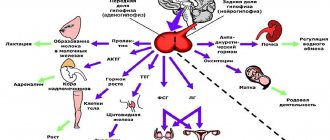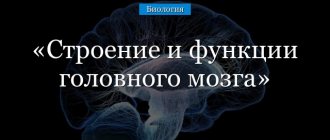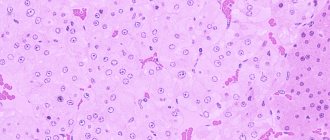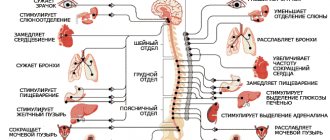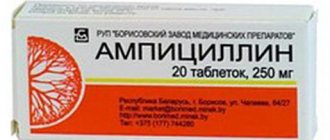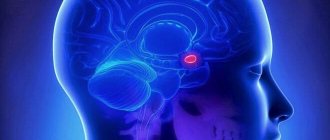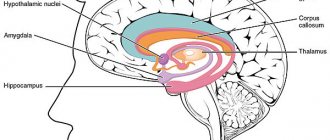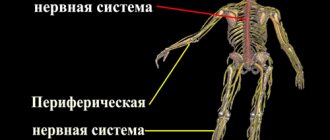With physiological regulation of the body, functions are carried out at an optimal level for normal performance, maintaining homeostatic conditions with metabolic processes. Its goal is to ensure that the body is always adapted to changing environmental conditions.
In the human body, regulatory activity is represented by the following mechanisms:
- nervous regulation;
- humoral regulation.
The work of nervous and humoral regulation is joint; they are closely related to each other. Chemical compounds that regulate the body affect neurons with a complete change in their state. Hormonal compounds secreted in the corresponding glands also affect the NS. And the functions of the glands that produce hormones are controlled by the NS, the importance of which in supporting the regulatory function for the body is enormous. The humoral factor is part of the neurohumoral regulation.
Coordinator No. 1 - nervous regulation
Autonomic nervous system
It was previously discussed that the heart has autonomy - the ability to independently reproduce impulses. And so it is. To some extent, the heart is “its own master,” but the activity of the heart, like the work of other internal organs, responds very sensitively to the regulation of the overlying departments, namely to nervous regulation. This regulation is carried out by a division of the nervous system called the autonomic nervous system (ANS).
The ANS includes two important components: the sympathetic and parasympathetic divisions. These departments, like day and night, have opposite effects on the action of internal organs, but both departments are equally important for the body as a whole. Let's consider how nervous regulation affects the functioning of the heart, blood pressure, and the tone of arterial vessels.
Glands
Special organs that secrete hormones and consist of secretory cells are called glands. In addition to hormones, the glands can produce other secretions that facilitate the digestion of food, the functioning of internal organs, the removal of harmful substances, etc. There are three types of glands
:
- internal secretion (endocrine) - have no ducts and secrete hormones into the blood;
- external secretion (exocrine) - through the excretory ducts they remove fluids to the surface or into the cavity (sweat, salivary, sebaceous, gastric, milk);
- mixed secretion - hormones are released into the blood, and secretions into the cavity or onto the surface (pancreas, genitals).
Rice. 1. The structure of the internal glands.
A description of the endocrine and mixed secretion glands is presented in the table “Humoral regulation” of the body.
| Glands | Location | Hormones | Action |
| Pituitary | Under the base of the brain | Somatotropin – growth hormone, thyrotropin, prolactin and others | The anterior part of the pituitary gland controls the functioning of other glands (reproductive, thyroid, adrenal glands), growth, blood pressure and water balance. The posterior lobe regulates the functioning of the bladder, the process of childbirth, milk production, skin pigmentation |
| Thyroid and parathyroid | Anterior to the larynx | Triiodothyronine, tetraiodothyronine (thyroxine), parathyroid hormone | Stimulate metabolism, regulate the growth and development of tissues, the level of oxygen consumed, the content of calcium and phosphorus |
| Thymus (thymus) | At the top of the chest | Thymosin, thymopoietin and others | Stimulates protective reactions, “trains” cells of the immune system |
| Adrenal glands | Above the kidneys | Three groups of corticosteroids - glucocorticoids (cortisone, corticosterone, hydrocortisone), mineralocorticoids (aldosterone, deoxycorticosterone) and sex hormones (androgens, estrogens, progesterone) | Affect metabolism, glycogen deposition in the liver, mood, slow down insulin, promote protein breakdown and nitrogen excretion, regulate the activity of the circulatory system |
| Pancreas | In the abdominal cavity behind the stomach | Insulin, glucagon | Regulate carbohydrate metabolism, control blood sugar levels |
| Reproductive – ovaries or testes | Females - in the abdominal cavity, males - in the scrotum outside the body | Women – estrogens and progestins, men – androgens and testosterone | Control puberty, development of genital organs, appearance of secondary sexual characteristics |
Rice. 2. Human endocrine glands.
In addition to hormones, the pancreas secretes gastric juice into the duodenum, and the gonads produce sperm and eggs.
Rice. 3. Cellular structure of the pancreas.
Sympathetic activity
Organization of the sympathetic nervous system
The sympathetic division of the ANS consists of a central part, located in the spinal cord, and a peripheral part, which is located directly in the ganglia - nerve nodes. Sympathetic control is exercised by the pituitary gland, hypothalamus, vasomotor center of the medulla oblongata, as well as the cerebral cortex. All these regulatory bodies are interconnected and do not work without each other. When is the sympathetic department activated and how does it manifest itself?
A surge of emotions, surging feelings, fear, shame, pain - and now the heart is ready to jump out of the chest, and blood is pulsating in the temples... This is all a manifestation of the effects of sympathy on the work of the heart and the regulation of vascular tone. Also in the walls of arterial vessels there are peripheral receptors that transmit signals to overlying structures when blood pressure decreases; in this case, sympathetic regulation “forces” the vessels to increase tone - and the pressure is normalized.
SA node
Based on these data, we can conclude that impulses to the sympathetic departments can come both from the periphery - the vessels, and from the center - the cerebral cortex. In both cases, the answer will arrive immediately. And what will be the answer? The effects of sympathy on the functioning of the heart and blood vessels have an effect with the sign: “+”. What does this mean? Increased heart rate, increased depth and strength of contractions, increased blood pressure, and increased vascular tone.
The heart rate in a healthy heart is set by the SA node; sympathetic fibers cause this node to produce a greater number of impulses, due to which the heart rate increases. Since sympathetic fibers innervate the ventricles of the heart to a greater extent, the strength and frequency of ventricular contractions will increase, and less time will be spent on their relaxation. Thus, sympathetic nervous regulation mobilizes the work of the heart and blood vessels by increasing their tone and increasing the strength, frequency, and depth of cardiac impulses.
Humoral regulation of functions in the human body
1. Humoral regulation of functions in the body.
Humoral regulation (from the Latin humor - liquid) is one of the mechanisms for coordinating vital processes in the body, carried out through body fluids (blood, lymph, tissue fluid) with the help of biologically active substances secreted by cells, tissues and organs during their functioning. Hormones play an important role in humoral regulation. Humoral regulation is subordinated to nervous regulation, together with which it forms a unified system of neurohumoral regulation, ensuring the normal functioning of the body in changing environmental conditions.
Humoral regulation, coordination of physiological and biochemical processes carried out through the fluid media of the body (blood, lymph, tissue fluid) with the help of biologically active substances (metabolites, hormones, hormonoid ions) secreted by cells, organs and tissues during their vital activity. In highly developed animals and humans, humoral regulation is subordinated to nervous regulation and together with it constitutes a single system of neurohumoral regulation. Metabolic products act not only directly on effector organs, but also on the endings of sensory nerves (chemoreceptors) and nerve centers, causing certain reactions by humoral or reflex means. So, if, as a result of intense physical work, the CO2 content in the blood increases, this causes excitation of the respiratory center, which leads to increased breathing and the removal of excess CO2 from the body. Humoral transmission of nerve impulses by chemicals, so-called. mediators, carried out in the central and peripheral nervous system. Along with hormones, it plays an important role in G. birth. products of interstitial metabolism play.
Humoral regulation is carried out in two ways:
1) the system of endocrine glands or endocrine glands (Greek endon - inside, crino - to secrete), the products of which (hormones) enter directly into the blood and act remotely on organs and tissues remote from them, as well as the system of endocrine tissues of other organs;
2) a system of local self-regulation, i.e., the effect on neighboring cells (within one organ or tissue) of biologically active substances (tissue “hormones” - histamine, serotomine, kinins, prostaglandins) and products of cellular metabolism (for example, the appearance of lactic acid in the muscles leads to dilation of blood vessels in them and increased oxygen delivery).
2. Characteristics of hormones and endocrine glands.
In the human body, the endocrine glands are represented by the secretory nuclei of the hypothalamus, in the brain area - the pituitary gland, pineal gland, thyroid, parathyroid glands, endocrine parts of the pancreas and gonads, adrenal glands, as well as individual endocrine cells scattered throughout other organs and tissues.
The central part of the endocrine system includes the hypothalamus, pituitary gland and pineal gland.
To the peripheral link - dependent on the anterior lobe of the pituitary gland - the thyroid gland, adrenal cortex, gonads, and independent of it - the parathyroid glands, the adrenal medulla and individual hormone-producing cells of non-endocrine organs.
According to their chemical structure, hormones are divided into three groups: proteins and peptides; steroids; amino acid derivatives.
The structural and functional organization of the endocrine system is characterized by: 1) a hierarchical principle of interaction - the lower level consists of glands, the second level consists of tropic hormones that regulate the activity of these glands, the third is the release of tropic hormones. Which are controlled by neurohormones of the hypothalamus; 2) the presence of a feedback system ensures the activity of the endocrine glands.
Due to the fact that this effect is provided by hormones delivered by blood to target organs, it is customary to talk about the humoral regulation of these organs according to the feedback principle. As a result of this connection, the content of hormones in the blood is maintained at an optimal level for the body. However, it is known that all processes occurring in the body are under constant control of the central nervous system. This dual regulation of organ activity is called neurohumoral. Changes in the functions of the endocrine glands cause severe disorders and diseases of the body, including mental disorders.
Many parts of the nervous system take part in the humoral regulation of the functions of internal organs. The main ones are: Hypothalamus (hupothalamus) - a special section of the diencephalon and the pituitary gland - a cerebral appendage located on the lower surface of the brain, which is a typical endocrine gland. Substances released into the blood by these parts of the brain are called neurohormones. The hypothalamus and pituitary gland are closely connected in their activities, forming a single hypothalamic-pituitary system. It ensures the constancy of blood composition and the necessary level of metabolism. Control of the hypothalamus over the internal organs is possible due to the fact that it regulates the functions of the pituitary gland - the main endocrine gland, which controls the activity of all other endocrine glands: thyroid, pancreas, genitals, adrenal glands. The functioning of the hypothalamic-pituitary system is based on the principle of feedback. When some endocrine glands begin to secrete too little or, conversely, too much hormones, the hypothalamus detects a deviation in their concentration in the blood from the currently required level. Then, stimulating or inhibiting the pituitary gland and through it the corresponding endocrine gland, the hypothalamus transfers its function to the desired level. The hypothalamus acts in two ways. The neurohormones it produces through special vessels enter directly into the anterior lobe of the pituitary gland, and the effect on its posterior lobe is carried out through special nerve fibers. The hypothalamic-pituitary system is a typical example of the close combination of nervous and humoral ways of regulating the functions of our body.
Pituitary gland (hypophysis)
The activity of the endocrine glands is controlled by numerous direct and feedback connections in the body. The main regulator of their functions is the hypothalamus, which is directly connected to the main endocrine gland - the pituitary gland, the influence of which extends to other peripheral glands.
Functions of the Pituitary Gland. The pituitary gland consists of three lobes: 1) the anterior lobe (adenohypophysis), 2) the intermediate lobe and 3) the posterior lobe or neurohypophysis. In the adenohypophysis, the main secretory function is distinguished by 5 groups of cells that produce 5 specific hormones. Among them are tropic hormones (lat. direction), regulating the functions of peripheral glands, effector hormones that directly act on target cells. Tropic hormones include the following: corticotropin or adrenocorticotropic hormone (ACTH), which regulates the functions of the adrenal cortex; thyroid-stimulating hormone (TSH), which activates the thyroid gland; gonadotropic hormone (GTH), which affects the functions of the gonads. The effector hormones are growth hormone (GH) or somatotropin, which determines body growth, and prolactin, which controls the activity of the mammary glands. The release of hormones from the anterior pituitary gland is regulated by substances produced by the neurosecretory cells of the hypothalamus and hypothalamic neuropeptides: stimulating secretroglyberins and inhibiting it - statins. regulatory substances are delivered by the blood stream from the hypothalamus to the anterior pituitary gland, where they influence the secretion of hormones by pituitary cells. Somatoropin is a species-specific protein that determines body growth (mainly increasing length growth). Work on genetic engineering with the introduction of somatotropin into the genetic apparatus of mice made it possible to obtain supermice twice as tall. However, modern research has shown that somatotropin of organisms of one species can increase body growth in species at lower levels of evolutionary development, but is not effective for more highly developed organisms. Currently, an intermediary substance has been found that transmits the effects of GH on target cells - somatomedin, which is produced by liver and bone tissue cells. Somatotrog ensures protein synthesis in cells, accumulation of RNA, enhances the transport of amino acids from the blood into cells, promotes the absorption of nitrogen, creating a positive nitrogen balance in the body, and helps in the utilization of fats. The release of somatotropic hormone increases during sleep, during physical exertion, injury, and some infections in the pituitary gland of an adult, its content is about 4-15 mg; in women, its average amount is slightly higher. The concentration of GH in the blood especially increases in adolescents during puberty. During fasting, its concentration increases 10-15 times. Excessive secretion of somatotropin at an early age leads to a sharp increase in body length (up to 240-250 cm) - and its deficiency leads to growth retardation - dwarfism. Giants and dwarfs have a proportional physique, but they exhibit changes in some body functions, in particular a decrease in the intrasecretory functions of the gonads. An excess of somatotropin in adulthood (after the end of growth) leads to the growth of parts of the skeleton that have not yet completely ossified - lengthening of the fingers and toes, hands and feet, ugly growth of the nose, chin, as well as enlargement of internal organs. This disease is called acromegaly. Prolactin regulates the growth of mammary glands, the synthesis and secretion of milk (milk excretion is ensured by another hormone, oxytocin), stimulates the instinct of motherhood, and also affects water-salt metabolism in the body, erythropoiesis, causes postpartum obesity and other effects. Its secretion is reflexively activated by the act of sucking. Due to the fact that prolacgin supports the existence of the corpus luteum and its production of the hormone progesterone, it is also called luteotropic hormone. Corticotropin (adrenocorticotropic hormone - ACTH) is a large protein, during the formation of which melanotropin (affecting the formation of the melanin pigment) and an important peptide - endorphin, which provides analgesic effects in the body, are released as by-products. The main effect of erticotropin is on the functions of the adrenal cortex, especially on the formation of glucocorticoids. In addition, it causes the breakdown of fats in adipose tissue, increases the secretion of insulin and somatotropin. The release of corticotropin is stimulated by various stressful stimuli - severe pain, cold, significant physical activity, psycho-emotional stress. By promoting increased protein, fat and carbohydrate metabolism in stressful situations, it provides increased resistance to adverse environmental factors, i.e. it is an adaptive hormone. Thyrotropin (thyroid-stimulating hormone - TSH) increases the mass of the thyroid gland, the number of active cells, promotes the uptake of iodine, which generally increases the secretion of its hormones. As a result, the intensity of all types of metabolism increases and body temperature rises. The formation of TSH increases when the external temperature decreases and is inhibited by injuries and pain. The secretion of TSH can be caused by a conditioned reflex pathway - according to signals preceding cooling, i.e., it is controlled by the cerebral cortex. This is of great importance for hardening processes and training for low temperatures. Gonadotropic hormones (GTH) - follitropin motropin (they are also called follicle-stimulating and luteinizing hormones) - are synthesized and secreted with them and the same cells of the pituitary gland, they are the same in men and women and are synergistic in their action. These molecules are chemically protected from destruction in the liver. GTH stimulates the formation and secretion of sex hormones, as well as the functions of the ovaries and testes. The content of GTH in the blood depends on the concentration of male and female sex hormones in the blood, on reflex effects during sexual intercourse, on various environmental factors, and on the level of neuropsychic disorders.
Posterior lobe of the pituitary gland. It secretes the hormone vasopressin, which is formed in the cells of the hypothalamus, then travels along nerve fibers to the neurohypophysis, where it accumulates and is then released into the blood. Vasopressin (lat. pressure) causes a dual physiological effect in the body. First, it causes blood vessels to narrow and blood pressure to increase. Secondly, this hormone increases the reabsorption of water in the renal tubules, which causes an increase in the concentration and a decrease in the volume of urine, i.e., it acts as a uretic hormone (ADH). Its secretion into the blood is stimulated by changes in water-salt metabolism, physical activity, and emotional stress. When drinking alcohol, the secretion of vasopressin (ADH) is inhibited, urine output increases and dehydration occurs. In the event of a sharp drop in the production of this hormone, diabetes insipidus occurs, manifested in pathological loss of water by the body. Oxytocin stimulates uterine contractions during childbirth and the secretion of milk by the mammary glands. Its secretion is enhanced by impulses from the mechanoreceptors of the uterus during its stretching, as well as the release of the female sex hormone estrogen. The intermediate lobe of the pituitary gland is almost undeveloped in humans; there is only a small group of cells that secrete melanotropic hormone, which causes the formation of melanin, the pigment of the skin and hair. This function in humans is mainly provided by corcotropin of the anterior pituitary gland. Posterior lobe of the pituitary gland The posterior lobe of the pituitary gland is essentially something intermediate between a gland and nervous tissue. In fact, it consists of nerve cells capable of producing hormones, which is why it is also called the neurohypophysis. The posterior lobe of the pituitary gland (neurohypophysis) has a close connection with the brain, which can have a stimulating or inhibitory effect on it. Hormones of the posterior lobe of the pituitary gland Vasopressin or antidiuretic hormone - Constricts blood vessels, reduces the excretion of water by the kidneys, thereby causing an increase in blood pressure. — Increases if work is accompanied by profuse sweating, preventing the body from dehydration. Oxytocin - Increases contraction of the uterine muscles during childbirth and miscarriages. — Promotes the separation of milk during feeding.
The pineal gland (glandula pinealis), or pineal gland, is a small oval glandular formation that belongs to the diencephalon and is located in a shallow groove between the superior colliculi of the midbrain. On the outside, the pineal body is covered with a soft connective tissue membrane, which contains many anastomosing blood vessels. The cellular elements of the parenchyma are specialized glandular cells - pineocytes, and glial cells - gliocytes. The endocrine role of the pineal gland is that its cells secrete hormones - antigonadotropin, melatonin and other hormones, as well as some liberins and statins. Melatonin is an antagonist of melanocyte-stimulating hormone, has an antigonadotropic effect and inhibits the development of gonads. The pineal body is involved in the regulation of electrolyte metabolism and influences at an early age the complex of endocrine organs (pituitary gland, thyroid gland, adrenal cortex) involved in the processes of growth and sexual development of the body.
Thyroid gland (glandula thyroidea). The thyroid gland has two groups of cells that produce two main types of hormones. One group of cells produces triiodothyronine and thyroxine, and the other produces calcitonin. The first cells capture iodine compounds from the blood, convert them into atomic iodine and, in combination with tyrosine amino acid residues, synthesize the hormones triiodothyronine and tetraiodironine or thyroxine (T4), which enter the blood and lymph. These hormones, activating the genetic apparatus of the cell nucleus and cell mitochondria, stimulate all types of metabolism and energy metabolism in the body. They enhance the absorption of oxygen, increase the basal metabolism in the body and increase body temperature, affect protein, fat and carbohydrate metabolism, ensure the growth and development of the body, enhance: the activity of sympathetic effects on heart rate, blood pressure and sweating, increase the excitability of the central nervous system. In the blood, thyroxine exists in an inactive form bound to proteins. Only about 0.1% of its amount is in the free active form, which causes functional effects. Triiodotinine has a more pronounced physiological effect, but its content in the blood is much lower. The hormone calcitonin (or thyrocalcitonin), together with the hormones of the parathyroid glands, is involved in the regulation of calcium levels in the body. It causes a decrease in the concentration of calcium in the blood and its absorption into bone tissue, which promotes bone formation and growth. Hormones of the gastrointestinal tract, in particular gastrin, are involved in the regulation of calcitonin secretion. If there is insufficient intake of iodine in the body, a sharp decrease in the activity of the thyroid gland occurs - hypothyroidism. In childhood, this leads to the development of cretinism - a delay in sexual, physical and mental development, and disturbances in body proportions. Thyroid hormone deficiency in adulthood causes mucous tissue swelling (myxedema). It occurs as a result of a disturbance in protein metabolism, which increases the oncotic pressure of tissue fluid and, accordingly, causes water retention in the tissues. At the same time, despite the growth of the gland (goiter), the secretion of hormones is reduced. To compensate for the lack of iodine in food and water, which exists in some regions and causes the so-called endemic goiter, iodized salt and seafood are included in the population's diet. Hypothyroidism can also occur due to genetic abnormalities, as a result of immune destruction of the thyroid gland and due to disturbances in the secretion of thyroid-stimulating hormone by the pituitary gland. In the case of hyperthyroidism (excessive production of thyroid hormones), toxic phenomena occur that cause Graves' disease. The thyroid glands grow (goiter), basal metabolism increases, weight loss, bulging eyes, and increased irritability are observed.
Parasympathetic activity
Parasympathetic system
The opposite effect is exerted by another department of the ANS - parasympathetic. Let's imagine: you had a delicious lunch and lay down to rest, your body is relaxed, warmth is spreading throughout your body, you are half asleep... How many beats per minute will your heart perform at this moment? Will the blood pressure be high? No. When you rest, your heart rests. During rest, the kingdom of the vagus begins. N.vagi is the most important and largest nerve of the parasympathetic system.
The action of parasympathetics has an inhibitory effect on the functioning of the heart and blood vessels, an effect with a “-” sign. Namely: the frequency and strength of heart contractions slows down, blood pressure decreases, and vascular tone decreases. Parasympathetic activity is maximum during sleep, rest, and relaxation. Thus, the two departments support cardiac activity, regulate its main indicators, and work harmoniously and clearly under the control of overlying structures of the nervous system.
Coordinator No. 2 - humoral regulation
Humoral regulation of heart activity
People who know Latin understand the meaning of the word “humoral”. If translated literally, humor is moisture, moist, related to blood and lymph. Humoral regulation of body functions is carried out with the help of blood, biological fluids, or rather, it is provided by substances that circulate in the blood. These substances that perform a humoral function are known to everyone. These are hormones. They are produced by the endocrine glands and enter the tissue fluid, as well as the blood. Reaching organs and tissues, hormones have a certain effect on them.
Hormones are extremely active, and they are also specific, since their action is aimed at certain cells, tissues, and organs. But hormones are quickly destroyed, so they must enter the blood constantly. Humoral regulation is carried out with the help of an important, main gland in the cranial cavity - the pituitary gland. He is the “king” of other glands of the body. Specifically, the heart is affected by hormones produced by the adrenal glands, the thyroid gland, sex hormones, as well as substances produced by heart cells.
The influence of neurohumoral regulation on the body
Neurohumoral regulation ensures almost all vital processes of the body:
- growth and development
- digestion,
- functioning of the cardiovascular system,
- breath
The nervous and humoral systems in higher animals and humans work in tandem and, when working in harmony, provide a quick response to changing environmental conditions.
As you can see, the word neurohumoral
consists of two parts -
nervous
and
humoral
regulation.
In this article we will take a closer look at humoral regulation, although the stimulus for the release of biologically active substances is provided by the nervous system.
Humoral regulation (from
humor
- “liquid”) is provided with the help of various body fluids and biologically active substances dissolved in them (hormones, enzymes, mediators, etc.).
Hormones (from Greek - hormao
“set in motion”, “induce”) - substances synthesized by the endocrine glands, which have the ability to influence processes occurring in a living cell through receptors. Each type of hormone has its own receptors that fit together like a key to a lock. And if this interaction breaks down, then serious diseases occur in the body. For example, the mechanism of development of diabetes mellitus is described on page 49 of the textbook “Grade 8 Biology” edited by I.V. Sivoglazov.
Biology. 8th grade. Textbook.
The textbook is included in the system of educational and methodological kits “Algorithm for Success”. Contains material on the section of the biology course “Man and His Health” and is designed to study the subject for 2 hours per week. The textbook includes laboratory and practical work on the main topics of the course. At the teacher's discretion, the last paragraphs of topics and blocks of “Test Yourself” tasks can be used for general lessons. An asterisk (*) indicates tasks performed by students of their choice and material studied in a review manner. The textbook provides an opportunity for in-depth study of biology in the 8th grade.
Buy
Substances that make the heart work
Effects of adrenaline on the heart
Adrenaline and norepinephrine. Adrenal hormones. They are produced in large quantities in extreme situations, during stress and anxiety. They increase the frequency and strength of heart contractions, increase blood pressure, and mobilize all body functions.
Thyroxine. Thyroid hormone. Increases heart rate. In people with excessive function of this gland and with an increased concentration of this substance in the blood, tachycardia is always observed - a heart rate of more than 100 per minute. Thyroxine also increases the sensitivity of heart cells to other substances that affect the humoral regulation of the functions of the cardiovascular system, such as adrenaline.
Sex hormones. Strengthen cardiac activity and maintain blood vessel tone.
Serotonin or the “happiness” hormone. Is it worth describing its effect? Everyone knows how the heart jumps out of the chest and beats with happiness?
Prostaglandins and histamine have a stimulating effect, “pushing” the heart.
Pathologies
A person feels the influence of the close relationship between nervous regulation and humoral control best in unusual conditions - when more effort is required to complete assigned tasks. For example, in the event of a fire with high air pollution, the load on the respiratory and cardiovascular systems increases.
Pathological conditions in the heart muscle are often the result of a malfunction in the secretion of adrenal hormones, adrenaline and norepinephrine. When they fluctuate in the bloodstream, various cardiac arrhythmias, tachycardias, and then heart failure occur. Nervous regulation does not always cope with the protective function, because hormones can maintain their influence on the heart for a long time.
Pathologies of the thyroid gland have been well studied. They lead to changes in metabolic processes. Oxygen consumption by tissues directly depends on their concentration. If there are a lot of them, then the body temperature rises, the absorption of nutrients accelerates, and body growth increases. All these symptoms are characteristic of hyperthyroidism. Whereas when the supply of hormones slows down, myxedema occurs - increased weight, body weight, apathy, decreased metabolic processes and temperature.
Pathologies of the reproductive system are difficult if they are based on hormonal imbalances. For example, the nature of the hairline, physique, voice modulation, and ability to reproduce change.
The prognosis for diseases of a humoral nature will largely be determined by the timeliness of a person seeking medical help and the correct selection of hormonal therapy. In most cases, doctors manage to achieve positive results in the fight to restore adequate regulation of internal organs.
Relaxing substances
Natriuretic hormone
Acetylcholine. Its influence has effects on the heart with a “-” sign: the frequency and strength of contractions decreases, the heart “works” less intensely.
Atrial hormones. Atrial cells produce their own substances that have an effect on the heart and blood vessels. These substances include natriuretic hormone; it has a pronounced dilating effect on blood vessels, reduces their tone, also causing a decrease in blood pressure. This substance also has a blocking effect on the activity of the sympathetic nervous system and the release of adrenaline and norepinephrine.
Ions in the work of the heart
Blood ion concentration
The concentration of ions or electrolytes in the blood has a great influence on heart contractions. We are talking about K+, Na+, Ca2+.
Calcium. The most important ion involved in cardiac contraction. Provides normal myocardial contractility. Ca2+ ions enhance cardiac activity. Excess calcium, as well as its deficiency, negatively affects the functioning of the heart; various arrhythmias or even cardiac arrest may occur.
Potassium. K+ ions in their excess slow down cardiac activity, reduce the depth of contraction, and reduce excitability. With a significant increase in concentration, conduction disturbances and cardiac arrest are possible. With a lack of K+, the heart also experiences negative effects in the form of arrhythmias and dysfunction. Electrolyte indicators in the blood are contained at a certain level, the indicators of which are established for each ion (potassium norms are 3.3-5.5, and calcium norms are 2.1-2.65 mmol/l). These indicators of humoral function are strictly defined, and if any of them goes beyond the norm, it threatens to cause disruption not only in the heart, but also in other organs.
One whole
Neurohumoral regulation of the heart
Both regulatory systems, nervous and humoral, are inextricably linked. It is impossible to separate one from the other, just as it is impossible in a single organism to distinguish between the functions of the right and left hands, for example. Some authors even call these systems in one word: neurohumoral regulation. This emphasizes their interconnection and unity. After all, managing the body is not an easy task and we can only cope with it together.
It is impossible to distinguish among the regulatory mechanisms the main and secondary ones; they are all equally important. We can only state some features of their work. Thus, nervous regulation is characterized by rapid response. Along the nerves, as if through wires, the impulse travels instantly to the organ. But the humoral regulation of functions is characterized by a slower onset of effect, because it takes time for the substance to reach the organ through the blood.

